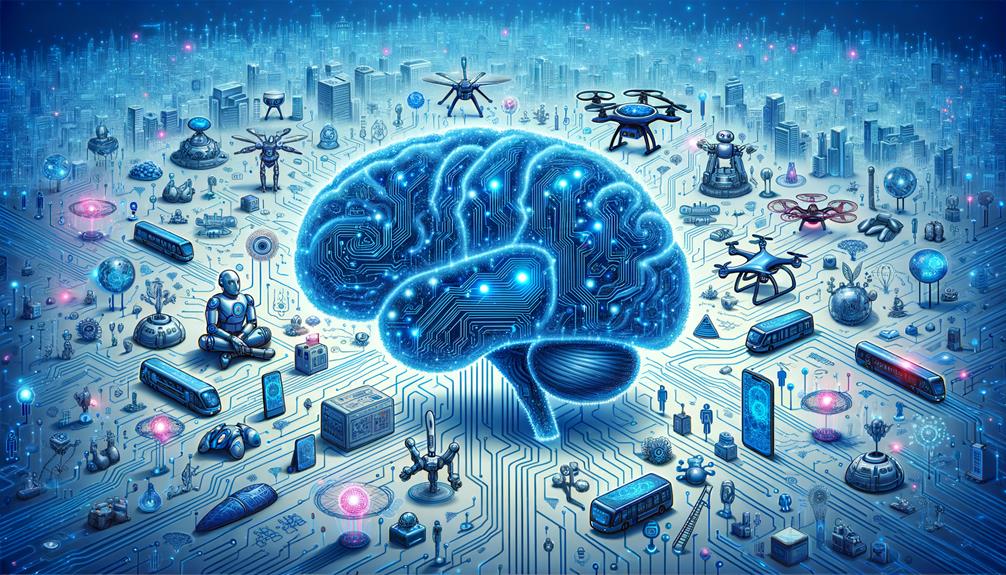

Vous êtes sur le point d'entrer dans le monde fascinant des intelligence artificielle[1]L'intelligence artificielle est un domaine dans lequel les machines apprennent, raisonnent et résolvent des problèmes comme les humains. L'IA est une branche de l'informatique qui utilise des algorithmes et de grands ensembles de données pour identifier des modèles et faire des prédictions par le biais d'un système d'information. techniques d'apprentissage automatique. En explorant ce domaine, vous rencontrerez différents types d'IA, tels que AI étroite et IA généraleChacun d'entre eux est conçu pour des tâches spécifiques ou des capacités cognitives plus générales. Votre voyage ne fait que commencer - avec l'évolution rapide de l'IA, il y a encore beaucoup à découvrir sur son potentiel de transformation des industries, ses limites et les rôles qu'elle peut jouer dans la vie quotidienne.
Lorsque vous entendez le terme "intelligence artificielle" (IA), vous faites probablement référence à une branche de l'informatique qui crée de la valeur ajoutée. systèmes intelligents capables d'effectuer des tâches qui nécessiteraient normalement une intelligence de type humain. Ce domaine, créé par John McCarthy en 1956, se concentre sur la construction de systèmes capables d'apprendre, de raisonner et de résoudre des problèmes comme les humains.
L'IA utilise des algorithmes et de grandes quantités de données pour identifier des modèles, faire des prédictions et améliorer ses performances grâce à techniques d'apprentissage automatique. Vous rencontrerez l'IA dans diverses applications, notamment AI étroite conçus pour des tâches spécifiques, tandis que les IA générale reste un objectif théorique.
Au fur et à mesure que l'IA progresse, elle transforme des secteurs tels que la santé, la finance et le service à la clientèle. Cependant, malgré ses progrès, l'IA a encore limitationsLa recherche sur l'intelligence générale et l'intelligence de l'enfant, en particulier bon sens.
Vous rencontrerez plusieurs types d'IA, chacun ayant des capacités et des applications distinctes, que l'on peut classer en fonction de leurs fonctionnalités et de leurs objectifs. Décortiquons les principaux types d'IA :
AI étroite: Conçu pour des tâches spécifiques, comme la reconnaissance vocale dans les assistants virtuels, il excelle dans des fonctions définies sans capacités cognitives plus larges.
IA générale: Vise à reproduire des capacités cognitives semblables à celles de l'homme dans diverses tâches, mais reste largement théorique.
L'IA super intelligente: Une forme hypothétique d'IA qui dépasserait l'intelligence humaine et les capacités de résolution de problèmes, ce qui permettrait de relever des défis mondiaux majeurs.
L'apprentissage automatique et l'apprentissage profond sont des éléments clés des applications d'IA, permettant aux systèmes d'apprendre à partir des données et de s'améliorer au fil du temps grâce à l'apprentissage supervisé, non supervisé et par renforcement.
Le traitement du langage naturel est un autre aspect essentiel de l'IA, qui permet aux systèmes de comprendre les humains et d'interagir avec eux de manière efficace.
La capacité de l'IA d'absorber et d'appliquer des connaissances est ancrée dans la culture de l'entreprise. apprentissage automatiqueL'intelligence artificielle est un sous-ensemble de l'intelligence artificielle qui permet aux systèmes d'apprendre à partir de données et d'améliorer leurs performances au fil du temps.
L'apprentissage automatique utilise algorithmes pour identifier des modèles dans de grands ensembles de données, en faisant des prédictions sans programmation explicite.
Il existe plusieurs méthodes clés, notamment apprentissage superviséoù les données étiquetées apprennent aux systèmes d'IA à classer les informations avec précision.
L'apprentissage non supervisé analyse et regroupe des données non étiquetées, tandis que l'apprentissage par renforcement récompense l'IA pour les actions correctes, améliorant ainsi la prise de décision au fil du temps.
L'apprentissage en profondeur utilise des réseaux neuronaux à couches multiples pour traiter des données complexes, améliorant ainsi les capacités de l'IA dans des tâches telles que la reconnaissance vocale et la reconnaissance d'images.
S'appuyant sur sa capacité d'apprentissage et d'adaptation, l'IA est aujourd'hui appliquée à divers secteurs, transformant notre mode de vie et de travail grâce à ses capacités impressionnantes dans des domaines tels que les soins de santé, la finance et les transports.
Vous utilisez probablement déjà l'IA dans votre vie quotidienne, que ce soit par l'intermédiaire d'assistants virtuels comme Siri ou Alexa, ou lorsque vous utilisez des services bancaires et de transaction en ligne qui s'appuient sur... apprentissage automatique pour détection des fraudes.
Voici quelques exemples de la manière dont Applications de l'IA font la différence :
En tant que Applications de l'IA s'intègrent de plus en plus dans les différents aspects de la vie, en atténuant les risques et en répondant aux besoins de la population. préoccupations éthiques associées à son développement et à son déploiement sont devenues des priorités essentielles.
Vous devez être conscient des préjugés potentiels que l'IA peut perpétuer, ce qui peut conduire à des résultats faussés et renforcer l'image de marque de l'entreprise. les inégalités sociétales. Il est essentiel de garantir la responsabilité, l'équité et la protection des droits de l'homme, en particulier à mesure que les capacités de l'IA se développent.
L'automatisation soulève également des préoccupations concernant déplacement d'emploitandis que la dérive du modèle met en évidence la nécessité d'effectuer des mises à jour continues pour maintenir la précision.
Pour faire face à ces risques, vous devez établir des priorités la transparenceIl s'agit d'un processus d'apprentissage, d'essais rigoureux et d'évaluation continue. Ce faisant, vous pouvez exploiter la puissance de l'IA tout en minimisant ses impacts négatifs potentiels.
Pour accéder au plein potentiel de l'intelligence artificielle tout en minimisant ses risques, vous devez donner la priorité aux éléments suivants Utilisation responsable de l'IA en établissant et en respectant des lignes directrices et des principes rigoureux. Il s'agit de créer cadres éthiques qui garantissent la transparence, responsabilitéet l'équité dans les processus de prise de décision en matière d'IA.
Vous devrez aborder les points suivants les biais potentiels dans les données d'apprentissage qui peuvent conduire à des résultats faussés. Voici quelques éléments clés à prendre en compte :
De soins de santé et financer à service clientèle et les transports, vous interagissez probablement avec des intelligence artificielle dans divers aspects de votre vie quotidienne, souvent sans même vous en rendre compte.
Dans le domaine de la santé, les applications de l'IA améliorent la précision des diagnostics et créent des plans de traitement personnalisés grâce à l'apprentissage automatique.
Vous bénéficiez également de l'IA dans le service client, où les chatbots fournissent une assistance 24 heures sur 24 et 7 jours sur 7.
En outre, véhicules autonomes utilisent la vision artificielle et l'apprentissage automatique pour naviguer en toute sécurité.
Dans la finance, les systèmes d'IA détectent les fraudes et réduisent les coûts opérationnels.
Les outils d'IA générative transforment même les domaines créatifs tels que l'art et la musique.
Ces applications d'IA révolutionnent les industries et vous facilitent la vie.
Au fur et à mesure que la technologie de l'IA progresse, vous pouvez vous attendre à voir de plus en plus d'applications de l'IA. des applications innovantes à l'avenir.
De plus en plus, vous verrez intelligence artificielle transformer tous les aspects de votre vie, grâce à des avancées significatives dans les domaines suivants un raisonnement de type humain et des services personnalisés à l'horizon.
Au fur et à mesure de leur évolution, les technologies de l'IA joueront un rôle essentiel dans l'automatisation des processus dans divers secteurs, ce qui pourrait améliorer la productivité et créer de nouvelles possibilités d'emploi.
Voici quelques exemples de l'impact de l'IA sur votre vie :
Au fur et à mesure que l'avenir de l'intelligence artificielle se dessine, vous verrez de grandes améliorations dans votre vie quotidienne.
Vous pouvez commencer à apprendre l'IA en suivant des cours en ligne, en vous plongeant dans des projets pratiques et en maîtrisant des langages de programmation tels que Python. Explorez les outils d'IA, les forums communautaires et les didacticiels pour acquérir des bases solides et éviter les erreurs courantes des débutants.
Vous êtes sur le point de vous immerger dans l'IA, en explorant ses bases, notamment l'apprentissage automatique, les réseaux neuronaux et la science des données. Vous découvrirez des applications telles que le langage naturel, la vision artificielle et la robotique, tout en considérant les implications éthiques et l'impact de l'automatisation.
Vous faites partie des 70% de professionnels qui apprennent l'IA en autodidacte ! Grâce aux nombreuses ressources d'auto-apprentissage, aux cours en ligne et aux projets pratiques, vous pouvez maîtriser les concepts de l'IA. Fixez-vous des objectifs personnels, explorez des outils tels que TensorFlow et participez aux forums de la communauté pour réussir.
Vous expliquerez l'IA à un profane en simplifiant des concepts tels que l'apprentissage automatique, les réseaux neuronaux et le traitement des données, et en utilisant des exemples concrets tels que le langage naturel, la vision par ordinateur et les applications robotiques, tout en discutant des considérations éthiques et des avantages de l'automatisation.